What if Luke and Han Meet Again in Ep 7 Where Did My Mojo Go Youtube
![]()
![]()
![]()
![]()
- "A movie for a generation growing upward without fairy tales."
- ―George Lucas
Star Wars: Episode Iv A New Hope , originally released equally Star Wars , and currently marketed as only Star Wars: A New Hope [4] is a 1977 picture written and directed by George Lucas. It is the first function of the Star Wars original trilogy and the first Star Wars film released.
The moving picture is set 19 years after the formation of the Galactic Empire and the events of Revenge of the Sith; structure has finished on the Death Star, a weapon capable of destroying a planet. After Princess Leia Organa, a leader of the Rebel Alliance, receives the weapon's plans in the promise of finding a weakness, she is captured and taken to the Death Star. Meanwhile, a immature farmer named Luke Skywalker meets Obi-Wan Kenobi, who has lived in seclusion for years on the desert planet of Tatooine. When Luke'due south home is burned and his aunt and uncle killed, Obi-Wan begins Luke's Jedi preparation equally they—along with Han Solo, Chewbacca, C-3PO, and R2-D2—attempt to rescue the princess from the Empire.
Inspired past films like the Wink Gordon serials and the samurai films of Akira Kurosawa, as well every bit such disquisitional works as Joseph Campbell'due south The Hero with a Yard Faces and Frank Herbert's Dune books, Lucas began work on Star Wars in 1974. Ground-breaking in its apply of special effects, this is considered to be among the near successful—and near influential—films of all fourth dimension. Produced with a budget of US$11,000,000 and released on May 25, 1977, the flick became one of the about successful of all fourth dimension, earning $215 million in the United States and $337 one thousand thousand overseas during its original theatrical release, as well as winning several pic awards, including ten Academy Accolade nominations. It was re-released several times, sometimes with pregnant changes; the nearly notable versions were the 1997 Special Edition and the 2004 DVD, which were modified with CGI furnishings and recreated scenes. It was re-released in the Blu-ray format in September of 2011. The moving-picture show was selected to be preserved by the Library of Congress as part of its National Film Registry. The film was selected in 1989, the program's kickoff year in existence.
Contents
- ane Opening crawl
- two Synopsis
- 2.1 Assault on Tantive Four
- 2.two Luke's destiny
- ii.3 Rescue of the princess
- 2.iv Sacrifice and victory
- 3 Development
- 3.i Formulation
- three.2 Production
- iii.3 Music
- 3.4 Sound
- 3.5 Sources and inspirations
- 4 Release
- iv.1 Trade
- iv.two Re-releases
- 4.three Habitation video
- 5 Reception
- 6 Deleted scenes
- 6.one Aunt Beru's Blueish Milk
- vi.2 Luke in the Desert
- six.3 Tosche Station
- 6.iv Luke and Biggs
- 6.v Vader and Chief Bast
- half dozen.6 The Search for R2
- 6.7 Stormtrooper Search
- 6.8 Darth Vader widens the Search
- 7 Credits
- 8 Appearances
- 9 Sources
- 10 Notes and references
- 11 External links
Opening crawl
| ||
Synopsis
Assail on Tantive IV
nineteen years after the germination of the Galactic Empire and the events of Revenge of the Sith, the galaxy is in a country of civil war. The Rebel Alliance has won their starting time major victory by stealing plans to the Galactic Empire's secret weapon, the Death Star. Hoping that the stolen plans can save her people and restore freedom to the galaxy, Princess Leia Organa, who is in custody of the stolen plans attempts to race dwelling aboard the Tantive IV. However, her ship is intercepted by the Imperial I-form Star Destroyer Devastator over the desert planet of Tatooine.
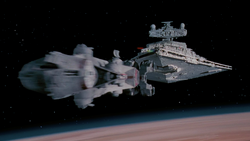
Princess Leia is captured by the Galactic Empire.
Imperial stormtroopers manage to lath the send, and later on defeating the small number of guards defending the transport, the Sith Lord Darth Vader arrives to assess the damage. Vader is outraged and questions Captain Antilles, whom he eventually strangles and kills. Hiding on the ship, Princess Leia is spotted by stormtroopers. They shoot her with a stun boom and bring her before Vader. However, before being detained, Leia was able to record a holographic message with the aid of R2-D2, and assigned the droid the responsibility of taking the message to a Jedi-in-hiding on Tatooine. Vader orders a message exist sent to the Royal Senate, informing them that the ship was destroyed, with everyone on board killed. R2-D2 and C-3PO apply an escape pod in order to escape the ship and attain the planet of Tatooine below.
Luke's destiny
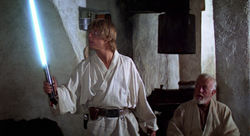
Luke Skywalker receives his father's lightsaber.
- "There's nothing for me here now. I desire to learn the ways of the Strength and become a Jedi like my father."
- ―Luke Skywalker
The droids are picked up past Jawa traders and later bought by moisture farmer Owen Lars and his nephew, Luke Skywalker, a immature farmer who lost his parents every bit a baby and hopes to ane day be a star fighter just similar his friends. While cleaning R2, Luke discovers the hologram, at the mention of Obi Wan, he wonders if she means Old Ben his neighbour. Eventually R2-D2 escapes from the Lars' homestead in search of an Obi-Wan Kenobi, whom the droid claims to exist the property of. Luke searches the desert only the droid is nowhere in sight, so he and C-3PO discover R2 the next day simply before they are attacked by Sand people. Luke and his droids are rescued by Obi-Wan Kenobi or, as Luke knows him, Ben Kenobi. Obi-Wan takes Luke to his home.
Luke receives his father'southward lightsaber, every bit Obi-Wan recalls his ain friendship with Luke's father. Luke is told that a Jedi named Darth Vader betrayed and murdered his begetter. After discovering Princess Leia'south message carried past R2-D2, Obi-Wan attempts to persuade Luke to accompany him to Alderaan. Luke refuses to get until he discovers that the traders who plant the droids were killed by what they thought to be the sand people (though it was really by stormtroopers searching for the droids). Realizing this, Luke hurries home only to detect his aunt and uncle were brutally murdered by the same stormtroopers. Luke returns upset, but Obi-Wan tells him if he was there, he would take been killed and the droids would be in possession of the Empire. With nothing keeping him hither, Luke, Obi Wan and the two droids travel to Mos Eisley to detect passage to Alderaan, Princess Leia'southward home planet.
For 17,000 credits, two,000 in advance and 15,000 upon arrival, smuggler Han Solo and his First Mate, a Wookiee named Chewbacca, agree to take the 4 of them to Alderaan aboard their ship, the Millennium Falcon. Afterward brief scuffles with the Empire and henchmen sent by Jabba the Hutt, the Falcon escapes the Imperial Blockade at Mos Eisley and Han sets a grade for Alderaan, unaware that the planet was about to exist mercilessly destroyed past the Empire.
Rescue of the princess
- "Here's where the fun begins!"
- ―Han Solo
In Alderaan'southward identify, they find what seems to be an asteroid field. The planet was destroyed by the dreaded Death Star, on the orders of K Moff Tarkin, to set an case of the power of the Empire. The Millennium Falcon is pulled aboard the Expiry Star by its powerful tractor axle.
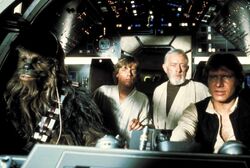
Heroes en route to the Death Star
From subconscious smuggling compartments, Solo ambushes two stormtroopers of the Imperial scanning crew. With Han and Luke at present disguised as the two stormtroopers, the group begins to figure out how to escape. Obi-Wan separates from the group to disable the tractor beam, leaving the others solitary. While connected to the Imperial Network, R2-D2 discovers Princess Leia is aboard the station. Luke convinces Han and Chewbacca to rescue her with the vague promise of a g advantage. Han and Chewbacca reluctantly concord. Luke plans to march into Detention Block AA-23, claiming that Chewbacca is part of a prisoner transfer. C-3PO and R2-D2 are instructed to remain backside, and the trio sets off on their rescue try. Luke's program works flawlessly in that they are quick to subdue the officers and guards in the princess's cell block. Unfortunately, no one thought to plan for their escape, and Leia takes charge, blasting a hole in a nearby grate and jumping through while Han and Luke hold off a squad of stormtroopers. Chewbacca, Luke and Han all dive after the princess into the unknown.
Unfortunately, the grate covers a chute that leads to a garbage compactor that is also home to a resident dianoga. Soon after landing, the fauna pulls Luke nether the surface, but releases him and is scared away when the Imperials realize where the heroes escaped to and activate the compactor. As the walls shut in on the foursome, Luke desperately calls to C-3PO over his comlink asking for the compactor to be shut down. Leia struggles to get to the acme and Chewbacca tries to unlock the door. R2-D2 manages to close downward the compactor but in time, although, among the muffled cries of joy over the comlink, C-3PO is briefly convinced that his master and friends have been crushed.
Afterward escaping from the trash compactor, the group hurries back to the Millennium Falcon, hoping that Obi-Wan has successfully close down the tractor beam. They meet stormtroopers on their way to the ship, evading and diggings their way by them.
Sacrifice and victory
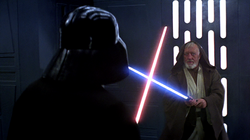
"You tin't win, Darth. If y'all strike me down, I shall become more than powerful than you can possibly imagine."
- "This will be a day long remembered. It has seen the terminate of Kenobi. Information technology will soon meet the finish of the Rebellion."
- ―Darth Vader
Obi-Wan, on the other hand, was destined to see with Darth Vader. After a short duel with his sometime Padawan, Obi-Wan sacrifices himself, thus becoming one with the Force and allowing Luke and the others to escape. Horrified and angered having witnessed Obi-Wan's demise at the hands of Vader, Luke takes his terminal blasts at the stormtroopers and dashes onto the Millennium Falcon.
Afterwards fighting a squadron of Necktie fighters, the Millennium Falcon meets the Rebel Alliance on Yavin iv, and the information in R2-D2 is turned over. General Dodonna plans the attack on the Decease Star, an assault so audacious every bit to receive an unenthusiastic reaction from the pilots. To add to Luke'south dismay, Han leaves later on receiving his reward.
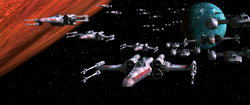
Rebel fighters arroyo the Death Star.
The Rebel strike force begins its attack on the Death Star, every bit the space station approaches the Rebel base of operations on Yavin 4. A group of starfighters assaults a trench on the Death Star'due south surface to hit the station's vulnerable spot before it can destroy the Alliance'south base. During this, most of the Insubordinate arts and crafts, including Luke's friend Biggs Darklighter, are picked off past Regal fighters led by Darth Vader. Simply as Vader opens fire on Luke from his personal TIE Advanced fighter, Han returns in the Millennium Falcon and attacks the Imperials, resulting in Vader'due south transport getting knocked out of the trench. Luke, aided by the vocalisation of Kenobi and guided by the Force, accurately fires two proton torpedoes into a small exhaust port leading to the Death Star's reactor, and the boxing station explodes.
The few remaining ships (those of Wedge Antilles, Luke, Han, and a Y-fly Pilot) render to Yavin 4 and a victory celebration commences, complete with medals for the heroes, Han Solo and Luke Skywalker, presented past Princess Leia.
Development
Conception
During mail-product on his previous film, American Graffiti, Lucas repeatedly discussed the concept of a "infinite opera" with producer Gary Kurtz.[5] In January 1973 Lucas began piece of work on this, and by May had prepared a 14-page story outline for distribution amid picture show studios.[five] He had originally envisioned the pic as being a continuation of both American Graffiti and Apocalypse Now (the latter of which he helped make earlier Warner Bros. Studios shut down his studio of American Zoetrope and thus forced him to hand over evolution to his compatriot, Francis Ford Coppola). His notation for the bones plotline for the picture show, which was intended to be a response to the Vietnam War era, was that it involved "a technological empire going after a modest band of freedom fighters."[half-dozen] [7] According to Walter Murch, a former acquaintance of Lucas when the latter was filming Apocalypse Now, the space opera setting was conceived in big role considering, due to the Vietnam War still going on, the audiences would not accept been receptive to a direct attack on American involvement in Vietnam.[8] [9] Because of its outer infinite setting, the story was viewed every bit science fiction, an unpopular genre at the box office. Lucas later proposed that terms like "space fantasy" or "scientific discipline fantasy" better fit the story.[5] He brought the outline to Universal Studios and United Artists; both rejected the project (the onetime refused directly, while the latter withheld their respond until afterward the 10 solar day wait menstruation ended).[6] [7] He as well turned to Walt Disney Studios Motility Pictures, though they also turned him down.[vi] [7] Lucas disliked the studio organisation because his previous two films, American Graffiti and THX 1138, had been re-edited without his consent.[x] Still, aware that studios were unavoidable, he pursued Alan Ladd, Jr., the caput of 20th Century Flim-flam. Although Ladd did non grasp the technical side of the project, he believed that Lucas was talented. Lucas later stated that Ladd "invested in me, [but] he did not invest in the moving-picture show."[5]
Product
Lucas finished a draft of the screenplay in May 1974. As the draft developed, the characters evolved significantly. Early in evolution, Luke Skywalker's character changed from a lx-year-sometime general to a fellow member of a family of dwarfs;[5] [xi] the Corellian smuggler, Han Solo, was envisioned as a large, green-skinned monster with gills.[11] Chewbacca was inspired by Lucas' Alaskan malamute dog, Indiana, who often acted as the director's "co-pilot" past sitting in the passenger seat of his car.[11] The Force, a mysterious energy field, was initially conceived every bit the Kyber crystal, a "galactic holy grail."[12] [five] The completed script was as well long for one pic; however, Lucas refused to condense it. Instead, he expanded the first third of it into one film and left the rest for two future films, effectively creating the original Star Wars trilogy.[xiii] [five]
Lucas hired conceptual artist Ralph McQuarrie to create paintings of certain scenes during screenwriting. When Lucas delivered his screenplay to the studio, he included several of McQuarrie'south paintings.[14] 20th Century Fox approved a upkeep of $8,250,000; American Graffiti 's positive reviews allowed Lucas to renegotiate his bargain with Alan Ladd, Jr. and request the sequel rights to the film. For Lucas, this bargain protected Star Wars ' unwritten segments and most of the merchandising profits.[5] [15]
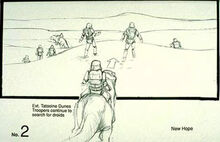
A storyboard console depicting Imperial stormtroopers searching for R2-D2 and C-3PO
In 1975, Lucas founded the visual effects company Industrial Light & Magic (ILM) after discovering that 20th Century Fox'south visual furnishings section had been disbanded. ILM began its work on Star Wars in a warehouse in Van Nuys, California. Most of the visual effects used motion control photography, which creates the illusion of size by employing small-scale models and slowly moving cameras. Model spaceships were constructed on the basis of drawings by Joe Johnston, input from Lucas, and paintings by McQuarrie. Lucas opted to abandon the traditional sleekness of science fiction by creating a "used universe" in which all devices, ships, and buildings looked anile and muddy.[5] [16] [17]
When filming began on March 22, 1976 in the Tunisian[18] desert for the scenes on the planet Tatooine, the project faced several problems.[source?] Lucas barbarous behind schedule in the commencement week of shooting due to a rare Tunisian rainstorm, malfunctioning props, and electronic breakdowns.[19] When thespian Anthony Daniels wore the C-3PO outfit for the first time, the left leg piece shattered down through the plastic covering his left foot, stabbing him. Afterwards completing filming in Tunisia, production moved into the more controlled environment of Elstree Studios, nearly London.[19] Even so, meaning problems, such as a crew that had niggling interest in the motion picture, nonetheless arose.[5] [19] Most of the crew considered the project a "children's film," rarely took their work seriously, and often found it unintentionally humorous.[xx] Actor Kenny Baker later confessed that he idea the film would exist a failure. Harrison Ford found the film "weird," in that at that place was a princess with buns for hair and what he called a "giant in a monkey suit" named Chewbacca.[source?] Ford also establish the dialogue difficult, maxim, "You can type this shit, George, just you sure can't say information technology."[21]
Lucas clashed with Director of Photography Gilbert Taylor, whom producer Gary Kurtz called "old-school" and "crotchety."[5] Moreover, with a background in contained filmmaking, Lucas was accustomed to creating most of the elements of the film himself. His photographic camera suggestions were rejected by an offended Taylor, who felt that Lucas was over-stepping his boundaries by giving specific instructions. Lucas eventually became frustrated that the costumes, sets and other elements were not living upwardly to his original vision of Star Wars. He rarely spoke to the actors, who felt that he expected too much of them while providing little management. His directions to the actors unremarkably consisted of the words "faster" and "more intense."[5]
Ladd offered Lucas some of the simply support from the studio; he dealt with scrutiny from board members over the ascent budget and complex screenplay drafts. After production brutal two weeks behind schedule, Ladd told Lucas that he had to finish production within a week or he would be forced to shut downwards production. The crew split into three units, led by Lucas, Kurtz, and product supervisor Robert Watts, respectively. Nether the new system, the project met the studio's deadline.[5] [19] ILM concluded shooting on April 22, 1977 with shot 110P, that of a Star Destroyer.[22]
Star Wars was originally slated for release in Christmas 1976; still, delays pushed the picture show's release to summer 1977. Already broken-hearted most meeting his deadline, Lucas was shocked when his editor's showtime cut of the film was a "complete disaster." After attempting to persuade the original editor to cut the film his way, Lucas replaced the editor with Paul Hirsch and Richard Chew. He too immune his then-wife Marcia Lucas to help the editing procedure while she was cutting the picture show New York, New York with Lucas' friend Martin Scorsese. Richard Chew found the film had an non-energetic pace; it had been cut in a by-the-volume style: scenes were played out in principal shots that flowed into close-upwardly coverage. He found that the pace was dictated past the actors instead of the cuts. Hirsch and Chew worked on ii reels simultaneously; whoever finished first moved on to the side by side.[five]
During production, the cast attempted to make Lucas laugh or grinning as he oft appeared depressed. At one betoken, the project became so demanding that Lucas was diagnosed with hypertension and burnout and was warned to reduce his stress level.[five] [19] Mail service-production was equally stressful due to increasing pressure from 20th Century Fox. Moreover, Mark Hamill's face was injured in a car accident, which made reshoots impossible.[19]
Meanwhile, ILM was struggling to accomplish unprecedented special effects. The company had spent half of its budget on four shots that Lucas deemed unacceptable.[19] Moreover, theories surfaced that the workers at ILM lacked discipline, forcing Lucas to intervene frequently to ensure that they were on schedule.[5] With hundreds of uncompleted shots remaining, ILM was forced to finish a year's work in six months. Lucas inspired ILM by editing together aerial dogfights from old war films, which enhanced the pacing of the scenes.[5]
During the anarchy of product and postal service-product, the team made decisions about character voicing and sound effects. Sound designer Ben Burtt had created a library of sounds that Lucas referred to as an "organic soundtrack." For Chewbacca'southward growls, Burtt recorded and combined sounds made past dogs, bears, lions, tigers, and walruses to create phrases and sentences. Burtt created the robotic vox of R2-D2 by filtering his voice through an electronic synthesizer. Darth Vader'due south breathing was achieved by Burtt breathing through the mask of a scuba tank implanted with a microphone.[23] Lucas never intended to use the voice of David Prowse, who portrayed Darth Vader in costume, because of Prowse'due south thick English West Country accent. He originally wanted Orson Welles to speak for Darth Vader. All the same, he felt that Welles' voice would exist too recognizable, so he cast the lesser-known James Earl Jones.[24] Nor did Lucas intend to employ Anthony Daniels' vocalism for C-3PO. 30 well-established voice actors, such every bit Stan Freberg, read for the voice of the droid. According to Daniels, one of the major voice actors recommended Daniels' vocalisation for the role.[5] [11]
When Lucas screened an early cut of the picture for his friends, among them directors Brian De Palma, John Milius and Steven Spielberg, their reactions were disappointing. Spielberg, who claimed to have been the only person in the audience to have enjoyed the film,[5] believed that the lack of enthusiasm was due to the absence of finished special effects. Lucas later said that the group was honest and seemed bemused by the film. In contrast, Alan Ladd, Jr. and the rest of 20th Century Fox loved the film; one of the executives, Gareth Wigan, told Lucas, "This is the greatest film I've ever seen," and cried during the screening. Lucas institute the experience shocking and rewarding, having never gained any approval from studio executives before.[5] Although the delays increased the budget from $8 million to $xi million, the film was still the to the lowest degree expensive of the Star Wars saga.
Music
Lucas'south intentions for Star Wars involved a thousand musical sound, with leitmotifs for different characters and important objects, an arroyo used to great effect, for case, in the operas of Richard Wagner. Toward this end, Lucas put together a drove of classical pieces for the composer John Williams to review, as an thought of what effects Lucas desired for the films. The music Williams composed was oft distinctly reminiscent of the original classical pieces. In particular:
- The music associated to the opening capture of the occludent runner is very similar to Mars, from Holst's The Planets. In the liner notes to the original soundtrack recording, Williams implicitly best-selling the connexion by explaining why he didn't just use Holst'south The Planets. He said that he felt he could requite the music a more than unified feel if he wrote information technology all himself.
- The "Force Theme" (or "Ben's Theme") has been compared to parts of the ballet Swan Lake.
- The music for the awards anniversary at the terminate of the movie begins with "the Force/Ben's Theme," and and then transitions into a theme that, in the liner notes, Williams says is reminiscent of "The Coronation," which probably refers to Elgar'south, or, more likely, William Walton's Coronation March.
- The opening title (the "theme from Star Wars," or "Luke's Theme") has been said to resemble John Barry's theme from Built-in Gratis, but has a like facade to the opening strains of the 1942 motion-picture show Male monarch's Row, scored past Erich Wolfgang Korngold. Later John Williams themes, such as those from Due east.T. the Extra-Terrestrial, take been said to resemble it. Listening to them together, i observes that none is identical to any of the others, but they use many of the same musical intervals to achieve similar, or at least related, emotional effects.[source?]
- The music for C-3PO's and R2-D2'southward arrival on Tatooine is very like to the beginning of the second part, titled The Sacrifice, of Igor Stravinsky'southward,The Rite of Spring,.
Major musical themes include:
- Star Wars Main Championship
- Princess Leia's Theme
- Binary Sunset
Sound
A New Hope was originally presented in monaural sound in many theaters, though the first-run 70mm prints were some of the earliest broad-release examples of surround audio—something not seen in the commercial cinema since the Cinerama and Cinemascope experiments of the early on 1950s.
Sources and inspirations
The film drew inspiration from a number of sources. This was conscious and has been acknowledged by George Lucas in interviews. It is characteristic of much myth-building.
Lucas has stated that Akira Kurosawa'southward 1958 film The Subconscious Fortress (USA release 1962) was a strong influence. The resemblance betwixt the two buffoon farmers in The Hidden Fortress and the two talkative droids in A New Hope is credible. Indeed, when the droids find themselves solitary on Tatooine, fifty-fifty the music and the style of "wipe" cuts are a clear homage to Hidden Fortress. When Motti is criticizing Darth Vader, he is about to mention the Rebels' "subconscious fortress" before Vader cuts him off in the middle of the last give-and-take.
The climactic scene in which the Expiry Star is assaulted was modeled after (including some of the same dialogue) the 1950s film The Dam Busters, in which RAF Lancaster bombers fly forth heavily defended reservoirs and aim "bouncing bombs" at German human-made dams in a bid to cripple the heavy industry of the Ruhr. (A New Hope cinematographer Gilbert Taylor had previously worked on the special-effects sequences for that flick.)
Lucas has made mention of the picture show "633 Squadron" directed by Walter Grauman when citing movies that inspired themes or elements in A New Hope. The "trench run" in A New Promise wherein Luke flies his X-wing through a "trench" on the Death Star and destroys the send was inspired, at least in small part, by the finale of 633 Squadron, which involves several Royal Air Force planes flight at depression level upwards a fjord against heavy, footing-based anti-shipping fire, to assail a manufacturing plant located at the base of a cliff at the canyon'south stop.
Release
Wary that Star Wars would be beaten out past other summer films, such as Smokey and the Bandit, 20th Century Flim-flam moved the release date to Midweek before Memorial Twenty-four hours: May 25, 1977. All the same, few theaters ordered the film to be shown. In response, 20th Century Fox demanded that theaters order Star Wars if they wanted an eagerly anticipated film based on a acknowledged novel titled The Other Side of Midnight.[5] The New York Times published the first advertisements for the film on May xv, but ten days before its premiere.[25]
Star Wars became an instant success upon release; within iii weeks, 20th Century Fox's stock toll doubled to a record high. Before 1977, 20th Century Fox'southward greatest annual profits were $37,000,000; in 1977, the visitor earned $79,000,000. Although the moving-picture show's cultural neutrality helped it to proceeds international success, Ladd became anxious during the premiere in Nihon. Subsequently the screening, the audience was silent, leading Ladd, Jr. to fright that the moving-picture show would be unsuccessful. He was later told that, in Japan, silence was the greatest honor to a motion picture. Meanwhile, thousands attended a ceremony at Grauman's Chinese Theater, where C-3PO, R2-D2 and Darth Vader placed their footprints in the theater'southward forecourt.[5]
During the film'south original theatrical run, there were a number of now-iconic tv promotions:
- A re-creation of the cantina set for The Richard Pryor Show (September 13, 1977)
- The Making of Star Wars Television set special (September xvi, 1977)
- A Star Wars–themed Donnie and Marie episode (September 23, 1977)
- Marker Hamill on The Bob Hope All Star Christmas Comedy Special (December 19, 1977)
- Pecker Murray's "Nick The Lounge Singer" singing the Star Wars Principal Theme on Sat Night Live (Jan 28, 1978)
- The Star Wars Holiday Special (November 17, 1978)[26]
- Carrie Fisher on Saturday Dark Live (November 18, 1978)
Merchandise
Charles Lippincott was hired past Lucas' production company, Lucasfilm Ltd., as marketing director for Star Wars. Because 20th Century Fox gave little back up for marketing beyond licensing T-shirts and posters, Lippincott was forced to look elsewhere. He secured deals with Stan Lee, Roy Thomas and Curiosity Comics for a comic book adaptation and with Del Rey Books for a novelization. Although Star Wars merchandise was bachelor to enthusiastic children upon release, only Kenner Toys—who believed that the motion-picture show would be unsuccessful—had accepted Lippincott'due south licensing offers. Kenner responded to the sudden demand for toys by selling boxed vouchers in its "empty box" Christmas campaign; these vouchers could be redeemed for the toys in March 1978.[5]
The novelization of the moving-picture show was published in December 1976, six months before the film was released. The credited author was George Lucas, but the volume was revealed to have been ghostwritten by Alan Dean Foster, who afterward wrote the showtime Expanded Universe novel, Splinter of the Heed'due south Eye. The volume was offset published as Star Wars: From the Adventures of Luke Skywalker; later editions were titled but Star Wars and, after, Star Wars Episode IV: A New Hope, to reflect the retitling of the picture show. Sure scenes deleted from the flick (and afterwards restored or archived in DVD bonus features) were present in the novel, such every bit Luke at Tosche Station with Biggs and the encounter betwixt Han and Jabba in Docking Bay 94. Other deleted scenes from the movie, such as a shut-up of a stormtrooper riding on a Dewback, were included in a photograph insert added to after printings of the volume. Smaller details were also inverse; for instance, in the Death Star set on, Luke's callsign is Blue Five instead of Red Five as in the film. Lippincott secured the bargain with Del Rey Books to publish the novelization in November 1976. By February 1977, a half million copies had been sold.[5]
A radio drama adaptation of the moving-picture show was written past Brian Daley, directed by John Madden, and produced for and circulate on the American National Public Radio network in 1981. The adaptation received cooperation from George Lucas, who donated the rights to NPR. John Williams' music and Ben Burtt'due south audio design were retained for the show; Mark Hamill (Luke Skywalker) and Anthony Daniels (C-3PO) reprised their roles equally well. The radio drama featured scenes not seen in the last cutting of the film, such as Luke Skywalker'south observation of the space battle above Tatooine through binoculars, a skyhopper race, and Darth Vader's interrogation of Princess Leia. In terms of Star Wars canon, the radio drama is given the highest designation, G-canon.[27]
Over the years, several comic adaptations of the picture show have been produced:
- Marvel Comics launched their Star Wars serial with a 6-part adaptation of the film written by Roy Thomas and illustrated past Howard Chaykin.
- In 1978, Al Williamson worked on an adaptation in comic strip form that was never released.
- Concurrently with the release of the 1997 Special Edition, Nighttime Horse Comics released a new 4-part accommodation written by Bruce Jones and illustrated by Eduardo Barreto.
- A manga accommodation illustrated by Hisao Tamaki was released in Japan in 1997 and in the United States in 1998.
Re-releases
The motion picture was originally released equally—and consequently often chosen—Star Wars, without Episode Iv or the subtitle A New Hope. The 1980 sequel, Star Wars: Episode V The Empire Strikes Back, featured the episode number and subtitle in the opening crawl. When the original film was re-released on April x, 1981, Episode IV: A New Hope was added above the original opening crawl.[28] Although Lucas claims that only six films were always planned, representatives of Lucasfilm discussed plans for nine or 12 possible films in early interviews.[29] The moving-picture show was re-released theatrically in 1978, 1979, 1981, 1982, and 1997.
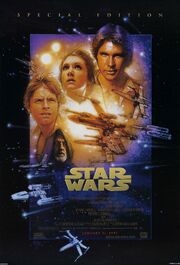
Official poster for A New Hope Special Edition release
After ILM used reckoner generated furnishings for Steven Spielberg's Jurassic Park, Lucas concluded that digital technology had caught up to his original vision for Star Wars.[5] As part of Star Wars ' 20th ceremony celebration in 1997, A New Promise was digitally remastered and re-released to theaters, along with The Empire Strikes Back and Return of the Jedi, under the campaign title The Star Wars Trilogy: Special Edition. The Special Edition versions contained visual shots and scenes that were unachievable in the original release due to fiscal, technological, and fourth dimension restraints; 1 such scene involved a meeting between Han Solo and Jabba the Hutt.[five] Although most changes were pocket-size or cosmetic in nature, some fans believe that Lucas degraded the movie with the additions.[30] For instance, a controversial change in which Greedo shoots first when confronting Han Solo has inspired T-shirts brandishing the phrase "Han shot first."[31]
Home video
A New Promise was released on DVD on September 21, 2004 in a box set with The Empire Strikes Back, Return of the Jedi, and a bonus disc of supplemental cloth. The movies were digitally restored and remastered, and more than changes were fabricated by George Lucas.
The DVD features a commentary track from George Lucas, Ben Burtt, Dennis Muren, and Carrie Fisher. The bonus disc contains the documentary Empire of Dreams: The Story of the Star Wars Trilogy, three featurettes, teaser and theatrical trailers, Telly spots, nonetheless galleries, an exclusive preview of Star Wars: Episode Three Revenge of the Sith, a playable Xbox demo of the LucasArts game Star Wars: Battlefront, and a "Making Of" documentary on the Episode Iii video game. The set was reissued in December 2005 equally role of a three-disc "limited edition" boxed gear up without the bonus disc.
The trilogy was re-released on split two-disc Limited Edition DVD sets from September 12, 2006 to December 31, 2006; the original versions of the films were added as bonus fabric. Controversy surrounded the release (often referred to as "George's original unaltered trilogy", or "GOUT" for curt) because the so-called "unaltered" versions were from the 1993 not-anamorphic laserdisc masters, and were not re-transferred to modern DVD standards.[32]
It was re-released in the Blu-ray format on September sixteen, 2011.[33]
On April 7, 2015, the Walt Disney Studios, 20th Century Flim-flam, and Lucasfilm jointly announced the digital releases of the six released Star Wars films. Fox released A New Hope for digital download on April ten, 2015 (while Disney released the other 5 films).[34]
Despite the Walt Disney Company's 2012 purchase of Lucasfilm Ltd. and the release rights to all future Star Wars films, Fox was to retain original distribution rights to A New Hope, which they co-produced and co-financed, in perpetuity in all media worldwide. Play a trick on was likewise to retain theatrical, nontheatrical, and dwelling house video rights worldwide for the franchise's five subsequent films, which Lucasfilm produced and financed independently, through May 2020, at which time buying was to transfer to Disney. This complex relationship between Play a joke on and Disney, particularly in regards to Fox'southward perpetual rights to Episode IV, was to create an obstruction for whatsoever future boxed set comprising all nine films.[35] On December 14, 2017, The Walt Disney Visitor announced that it was acquiring most of Flim-flam's parent company, 21st Century Fox, including the moving-picture show studio and all distribution rights to A New Hope.[36] On March 20, 2019, the deal was officially completed.[37] On April 12, 2019, a Blu-ray box set containing the nine master installments of the Star Wars saga remastered in 4K was reportedly appear to be in development for a 2020 release.[38]
Reception
Star Wars debuted on May 25, 1977 in 32 theaters, and proceeded to suspension house records, finer becoming one of the start blockbuster films.[39] It remains one of the most financially successful films of all time. Some of the cast and crew noted lines of people stretching around theaters as they drove by. Even technical crew members, such every bit model makers, were asked for autographs, and bandage members became instant household names.[5] The pic'southward original total U.S. gross came to $307,263,857, and it earned $6,806,951 during its first weekend in wide release. Lucas claimed that he had spent most of the release day in a sound studio in Los Angeles. When he went out for luncheon with his and then-married woman Marcia, they encountered a long queue of people along the sidewalks leading to Mann's Chinese Theater, waiting to see Star Wars.[19] The film became the highest-grossing film of 1977 and the highest-grossing picture show of all time until E.T. The Extra-Terrestrial broke that tape in 1982. (With subsequent re-releases, Star Wars reclaimed the title, but lost it again to James Cameron's 1997 blockbuster Titanic.) The film earned $797,900,000 worldwide, making it the first film to reach the $300 million mark.[40] Adjusted for inflation it is the second highest grossing pic of all time in the United States, behind Gone with the Wind.[41]
The New York Times described Star Wars: Episode 4 A New Hope as "the most cute movie serial ever made." Roger Ebert chosen the film "an out-of-torso experience," compared its special effects to those of 2001: A Space Odyssey, and opined that the true strength of the picture show was its "pure narrative."[42] Vincent Canby called the flick "the movie that's going to entertain a lot of contemporary folk who have a soft spot for the virtually ritualized manners of comic-volume adventure."[43] Pauline Kael of The New Yorker criticized the motion-picture show, stating that "there's no breather in the moving picture, no lyricism," and that it had no "emotional grip."[44] Jonathon Rosenbaum of the Chicago Reader stated, "None of these characters has whatsoever depth, and they're all treated similar the fanciful props and settings!"[45] Peter Keough of the Boston Phoenix said, "Star Wars is a junkyard of cinematic gimcracks not dissimilar the Jawas' heap of purloined, discarded, barely functioning droids."[46] Stanley Kauffmann of The New Republic also responded negatively, noting, "His piece of work hither seems less inventive than in THX 1138."[47] Co-ordinate to rottentomatoes.com, of the 54 disquisitional reviews of the film provided on that site, 51 responded favorably (95% of the reviewers), stating in consensus that "the activity and special effects are first charge per unit."[47]
In 1989, the U.S. National Film Registry of the Library of Congress selected the moving picture as a "culturally, historically, or aesthetically important" film.[48] In 2006, Lucas' original screenplay was selected by the Writers Guild of America equally the 68th greatest of all time.[49] The American Film Plant (or AFI) listed it 15th on a list of the tiptop 100 films of the 20th century;[50] in the Uk, a poll created by Channel Four named A New Promise (together with its successor, The Empire Strikes Dorsum) the greatest movie of all time.[51] The American Picture Institute has named Star Wars and specific elements of information technology to several of its "superlative 100 lists" of American cinema, compiled equally a part of the Constitute'southward 100th anniversary celebration. These include the 27th most thrilling American picture of all fourth dimension;[52] the thirty-ninth almost inspirational American film of best;[53] Han Solo as the fourteenth greatest American film hero of all time and Obi-Wan Kenobi thirty-seventh on the same list.[54] The often repeated line "May the Force be with you" was ranked as the eighth greatest quote in American moving picture history.[55] John Williams' score was ranked equally the greatest American film score of all fourth dimension.[56]
Star Wars won multiple awards at the 1978 Academy Awards, including Best Fine art Management-Set Ornamentation, which went to John Barry, Norman Reynolds, Leslie Dilley and Roger Christian. Best Costume Design was awarded to John Mollo; Best Moving-picture show Editing went to Paul Hirsch, Marcia Lucas and Richard Chew; John Stears, John Dykstra, Richard Edlund, Grant McCune and Robert Blalack all received awards for All-time Effects, Visual Effects. John Williams was awarded his third Oscar for Best Music, Original Score; the Best Sound went to Don MacDougall, Ray West, Bob Minkler and Derek Ball; and a Special Accomplishment for audio effects went to Ben Burtt. Additional nominations included Alec Guinness for Best Player in a Supporting Role, George Lucas for Best Screenplay and Best Director, and Gary Kurtz was nominated for his producing duties in Best Movie. At the Golden Globe awards, the picture was nominated for All-time Motion Picture - Drama, Best Director, Best Supporting Player (Alec Guinness), and All-time Score. It simply won the award for Best Score. It received vi BAFTA nominations: Best Picture show, Best Editing, All-time Costume, All-time Production/Fine art Blueprint, Best Sound, and All-time Score; the movie won in the latter ii categories. John Williams' soundtrack album won the Grammy laurels for All-time Anthology of an original score for a motion picture or telly program, and the flick was awarded the Hugo Laurels for Best Dramatic Presentation. In 1997, the MTV Movie Awards awarded Chewbacca the lifetime achievement award for his piece of work in the Star Wars trilogy.[source?]
Originally, if the film did poorly at the box office, Lucas planned to turn the novel Splinter of the Mind'due south Heart into a low-upkeep sequel to the picture. According to an interview with Alan Dean Foster in Empire magazine, the book was written to exist filmed as a low-upkeep sequel if Star Wars was non a huge success. Harrison Ford was not signed for the sequel as of the writing of the book, which is why Han Solo does non appear in the novel. Withal, with the success of A New Hope, Lucas was free to make The Empire Strikes Back.[source?]
Deleted scenes
There are many short alternating takes throughout Star Wars where Luke appears in his poncho: Luke in the desert, in the Tusken Raiders' coulee, Luke finding the destroyed homestead, and in the hangar on Yavin four. The but poncho scenes that fabricated the final cut were in Docking Bay 94, on the Millennium Falcon flight from the Decease Star, and on arrival on Yavin 4.
Aunt Beru's Blue Milk
Beru is in the homestead, pouring a blue liquid into a jug.
Luke in the Desert
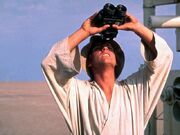
Luke with his macrobinoculars
Luke Skywalker is in the Tatooine desert repairing a moisture vaporator, assisted by a Treadwell droid, when he notices shining objects in the sky. With his macrobinoculars Luke sees two ships engaged in gainsay beyond the temper. He jumps into his landspeeder. The malfunctioning Treadwell blows a fuse and is unable to follow. Luke speeds off into the desert to find his friends. The scene originally occurred afterwards the Tantive Iv is boarded, just earlier Darth Vader'southward outset appearance in the film. It is thought that there is no longer any clear footage of this scene available. Existing footage has been degraded by poor motion-picture show storage atmospheric condition over the years. Earlier the flick was cutting, this was the audience'due south first sight of the young Luke Skywalker, much before than in the terminal cut. It was removed forth with subsequent scenes of Luke and his friends in Anchorhead. George Lucas had originally written the scenes and shot them at the suggestion of his industry friends who thought that audiences wouldn't empathise the story strictly beingness told from a droid'south point of view. Upon realizing that the story was really almost the droids' adventures and it was them leading things to Luke and Obi-Wan, etc. Lucas took the footage out.
Tosche Station
Luke's landspeeder races into the town of Anchorhead, near running over an former woman. Luke rushes into Tosche Station excitedly telling his friends about the battle higher up their planet. He is overjoyed to be reunited with his friend Biggs Darklighter who is on planet leave from the Academy. Deak, Windy, Camie, Fixer and Biggs all follow Luke exterior to see the battle with Luke's macrobinoculars. The battle appears to have ended and Luke's friends ridicule him for making information technology all up. This scene was to come just afterwards R2-D2 and C-3PO squirt from the Tantive IV in an escape pod, and earlier the scene where Princess Leia is led convict earlier Darth Vader. This scene establishes Luke's difficult relationships with his peers, and gives a flick of life on Tatooine. Storyline pacing may have been the deciding gene, simply information technology should too be borne in heed that subsequently Lucas's first screening of the rough cut of Star Wars in 1977, a fellow filmmaker jokingly defendant him of producing "American Graffiti in space." This jibe probably influenced Lucas to cut the scenes set in Anchorhead. The sequence where Luke nearly runs downwards an old adult female was an effects shot that was never completed.
Luke and Biggs
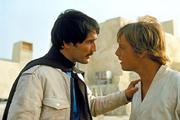
Luke says farewell to Biggs
This scene is a conversation between Luke and his oldest friend, Biggs Darklighter. Biggs has left Tatooine and is on planet leave from the Purple Academy where he is training to be a space airplane pilot. Luke's envy of Biggs'southward success conflicts with his duty to his uncle and his reasons for remaining on Tatooine. Biggs quietly tells Luke that he has decided to bring together the Rebellion confronting the Empire. In a tense and emotional conversation, the two immature men say their last farewells. This scene was to come in between the scene where C-3PO spots a distant Jawa sandcrawler in the desert, and the capture of R2-D2 by the Jawas in the canyon. The Luke and Biggs sequence was part of the whole Anchorhead backstory on Tatooine, and was cut along with the other early on scenes on Tatooine, probably for reasons of story pacing.
Vader and Chief Bast
In this short scene, Darth Vader and Primary Bast walk along a corridor on the Death Star. Bast reports that the search for the missing droids has extended to Mos Eisley spaceport. Vader observes that Princess Leia is resisting interrogation, and Bast boldly criticizes Tarkin's plan to break her equally "foolish." The scene would have appeared between the scene where Han Solo encounters Jabba the Hutt in Docking Bay 94 (likewise cut), and the scene where Luke and Ben find the Millennium Falcon in Docking Bay 94.
The Search for R2

C-3PO pilots the landspeeder
R2-D2 has absconded from his new master, Luke Skywalker. Early on in the morning, Luke and Threepio rush off in the landspeeder to search for R2, with Threepio driving the landspeeder. They talk about Artoo, Ben Kenobi, and how angry Uncle Owen is going to be. The scene belongs at the start of the sequence where Luke and 3PO search for R2, before the attack of the Tusken Raiders. The moment was scored with a calorie-free version of Luke'due south theme; the music can be heard at the starting time of the cue "Country of the Sand People" on the original LP and CD configurations, or "Landspeeder Search" in the Special Edition album. Before the days of CGI, scenes similar this landspeeder cockpit sequence had to be filmed against a rear-project screen. The scene was dropped due to poor quality.
Stormtrooper Search
Diverse alien creatures are seen walking around a narrow street in Mos Eisley, and some Stormtroopers walk past.
Darth Vader widens the Search
This is a scene with Darth Vader and some other Imperial officer on the Expiry Star.
Credits
Appearances
Sources
Notes and references
External links
collinsdoingunt93.blogspot.com
Source: https://starwars.fandom.com/wiki/Star_Wars:_Episode_IV_A_New_Hope


0 Response to "What if Luke and Han Meet Again in Ep 7 Where Did My Mojo Go Youtube"
Post a Comment